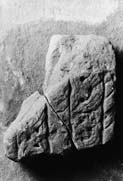Select a site alphabetically from the choices shown in the box below. Alternatively, browse sculptural examples using the Forward/Back buttons.
Chapters for this volume, along with copies of original in-text images, are available here.
Object type: Part of grave-cover, in two joining fragments
Measurements: L. (total) 47 cm (18.5 in) W. 43.5 > 42 cm (17.1 > 16.5 in) D. 18 cm (7.1 in)
Stone type: [Ancaster Freestone, Upper Lincolnshire Limestone, Inferior Oolite Group]
Plate numbers in printed volume: Fig. 9; Ills. 329–31
Corpus volume reference: Vol 5 p. 245-246
(There may be more views or larger images available for this item. Click on the thumbnail image to view.)
Two fragments which join to form a section from the central portion of a mid-Kesteven type grave-cover decorated with interlace in low relief. The stone has been split longitudinally and thus the lower half of each flank panel has been lost. The surviving part of the stone has also been broken longitudinally (perhaps in recent times) and there has been incidental damage at either end.
A (top): Stones 1a and b. This face is part of the monument's lid and is divided longitudinally by a broad undecorated central shaft, on either side of which are two runs of interlace. To one side a single strand of interlace with a double incised medial line forms the remains of two simple pattern E knots, whilst on the other, there is a three-strand plait with a single incised medial line. Both arrises are cable-moulded.
B (long): Stone 1a. This is part of one flank of the monument and includes a 'bull's head' (Fig. 11), from the horns of which develop two runs of three-strand plait including a simple pattern E knot. The bull's horns are ornamented with an incised medial line which crosses over the nose, above an undecorated raised nose band of rectangular section. Below the bull's head are traces of the fillet which divided the upper register of decoration on this flank from the lower, but not enough survives to say whether it was itself decorated. The arris between faces A and B is cable-moulded.
C and E (ends) and F (bottom): Broken away.
D (long): Stone 1b. This face (a fragment of the second flank panel) has been mostly broken away, but it is possible to identify a single knot of interlace with a double incised medial line. The motif represented might be type vii (Fig. 10). The arris between faces A and D is also cable-moulded.
This is the central section from a typical mid-Kesteven type grave-cover – it has the characteristic layout, style of interlace sculpture and range of motifs which make this clear and it is cut from the characteristic stone type (Chapter V). Within the group it represents rather a small monument with a more pronounced taper than many. The location of the stone within the grave-cover is reconstructed in Fig. 9 above. Like the other members of the group Sempringham 1 should probably be dated to the period between the mid tenth and the early eleventh century.



